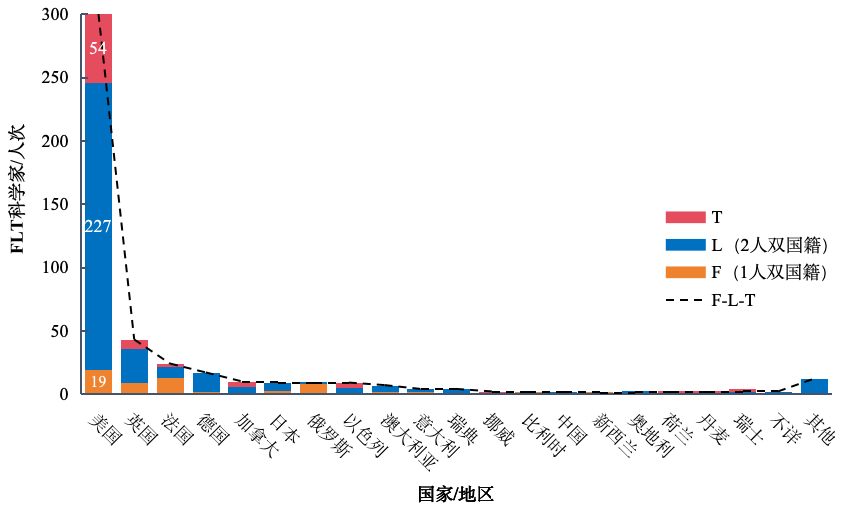 PDF(3227 KB)
PDF(3227 KB)


 PDF(3227 KB)
PDF(3227 KB)
 PDF(3227 KB)
PDF(3227 KB)
基于奖项信息学的国际科学奖项特征规律分析——以3项国际奖项为例
Analysis of Characteristics of International Scientific Awards Based on Prize Informatics
[目的/意义] 奖项信息学是学科信息学在科学奖项领域的应用研究方向。基于奖项信息学开展科学奖项的数据挖掘与知识发现研究,可以量化表征科学创新活动的演进规律。 [方法/过程] 在概述国际上科技奖项发展历程与奖项数据挖掘分析的研究价值的基础上,选择3项代表性科技领域国际权威奖项作为重点分析对象,进行系统地定量数据挖掘与科学演化规律测度。 [结果/结论] 实证分析发现,具有领域代表性的科学奖项普遍呈现出获奖国家机构集中化、获奖者老龄化、获奖时滞规律、创新峰值年龄中青年化、获奖者合作网络多样化、科学发现影响力演化等科学学特征或规律。
[Purpose/Significance] Prize Informatics is the applied research direction of Subject Informatics in the field of scientific awards. Research on data mining and knowledge discovery of scientific awards based on Prize Informatics can quantitatively characterize the evolution of scientific innovation activities. [Method/Process] Based on an overview of the development history of international scientific awards and the research value of award data mining analysis, this study further selected three internationally authoritative S&T awards as key analysis subjects, conducting systematic quantitative data mining and measuring the patterns of scientific evolution. [Result/Conclusion] Empirical analysis reveals that scientific awards with domain representativeness generally exhibit scientometric characteristics or patterns, including the centralization of award-winning countries and institutions, the aging of awardees, the award time lag, the trend of innovation peak ages being in the middle and youth, the diversification of awardees' collaboration networks, and the evolution of the impact of scientific discoveries.

prize informatics / subject informatics / scientific awards / evolutionary laws
| [1] |
张志强, 范少萍. 论学科信息学的兴起与发展[J]. 情报学报, 2015, 34(10): 1011-1023.
|
| [2] |
张雪, 张志强. 再论学科信息学发展与趋向[J]. 图书情报工作, 2023, 67(19): 3-17.
|
| [3] |
张志强, 等. 面向领域知识发现的学科信息学理论与应用研究[M]. 北京:科学出版社, 2023.
|
| [4] |
|
| [5] |
|
| [6] |
|
| [7] |
|
| [8] |
|
| [9] |
姚昆仑. 20世纪全球科技奖励的发展及特点分析[J]. 中国科技奖励, 2008, (2): 30-33.
|
| [10] |
|
| [11] |
王双, 赵筱媛, 潘云涛, 等.学术谱系视角下的科技人才成长研究——以图灵奖人工智能领域获奖者为例[J]. 情报学报, 2018, 37(12): 1232-1240.
|
| [12] |
张志强, 任晓亚, 门伟莉.诺贝尔科学奖的科学学规律及其对建设科技强国的启示[J]. 中国科技人才, 2024(5): 45-56.
|
| [13] |
任晓亚, 张志强, 陈云伟. 杰出科学家的科研产出规律——以拉斯克医学研究奖得主为例[J]. 情报学报, 2019, 38(9): 894-906.
|
| [14] |
门伟莉, 张志强. 机构属性的诺贝尔科学奖分布规律研究[J]. 情报学报, 2019, 38(9): 907-920.
|
| [15] |
门伟莉, 张志强.科研创造峰值年龄变化规律研究——以自然科学领域诺奖得主为例[J]. 科学学研究, 2013, 31(8): 1152-1159.
|
| [16] |
张洋, 朱嘉麒, 邵苏晨, 等.社会科学国际权威奖项得主的成果特征[J]. 图书馆论坛, 2023, 43(1): 49-59.
|
| [17] |
|
| [18] |
|
| [19] |
|
| [20] |
李淑敏, 王永伟.STS领域杰出人才的特征分析——以贝尔纳奖获得者为例[J]. 自然辩证法通讯, 2021, 43(7): 100-107.
|
| [21] |
|
| [22] |
|
| [23] |
|
| [24] |
The International Center for Data on Awards (ICDA)[EB/OL]. [2025-03-21].
|
| [25] |
IREG List of International Academic Award [EB/OL]. [2025-03-21].
|
| [26] |
|
| [27] |
任晓亚, 张志强. 主要科技领域国际权威奖项规律及其驱动因素分析[J]. 情报学报, 2019, 38(9): 881-893.
|
| [28] |
Fields Medal[EB/OL]. [2025-03-28].
|
| [29] |
Laker Award[EB/OL]. [2025-03-28].
|
| [30] |
A.M. Turing Award[EB/OL]. [2025-03-28].
|
| [31] |
|
| [32] |
张志强, 门伟莉. 诺贝尔物理学奖获得者中师承效应量化研究[J]. 情报学报, 2014, 33(9): 926-935.
|
| [33] |
|
/
| 〈 |
|
〉 |